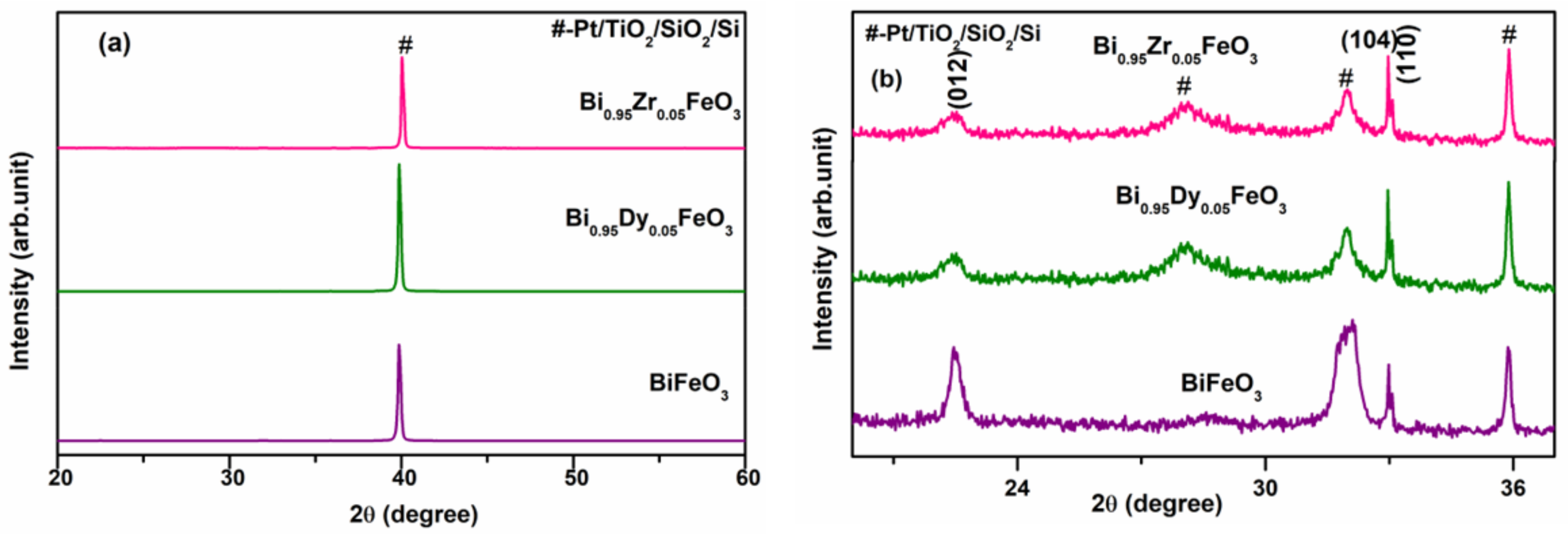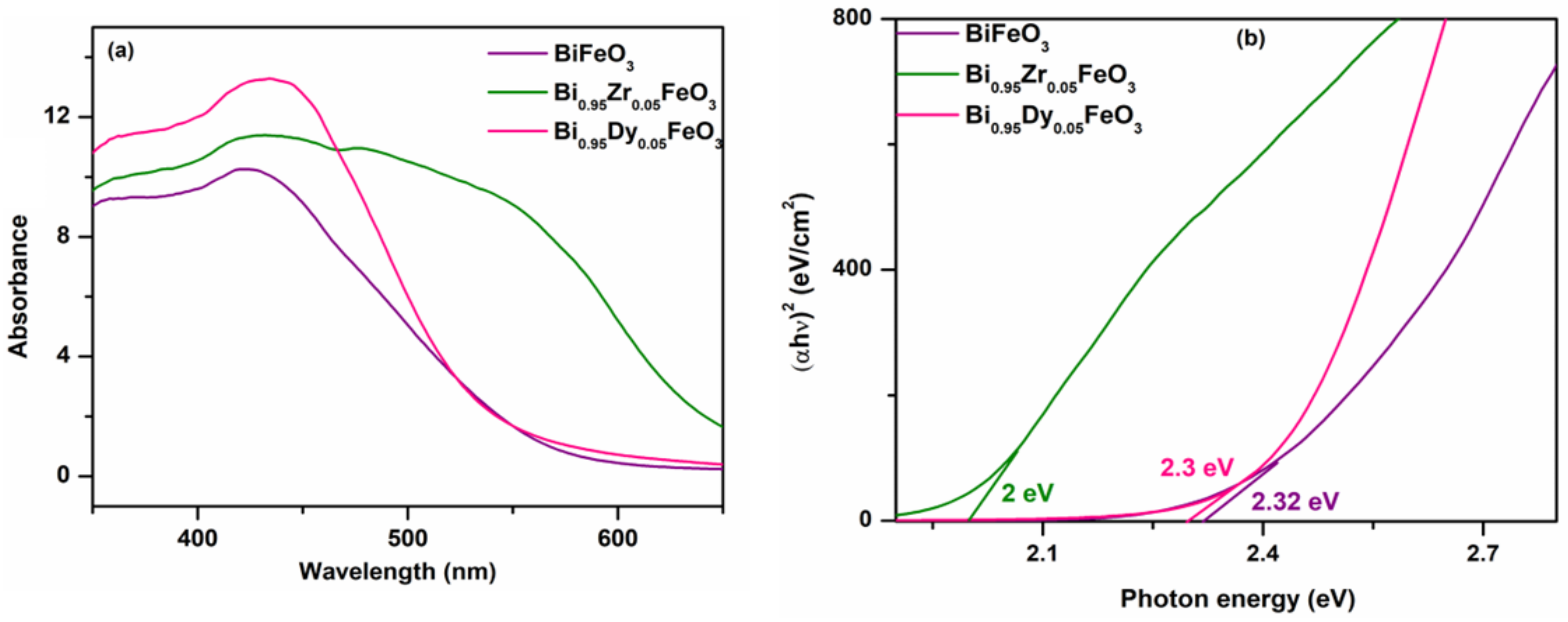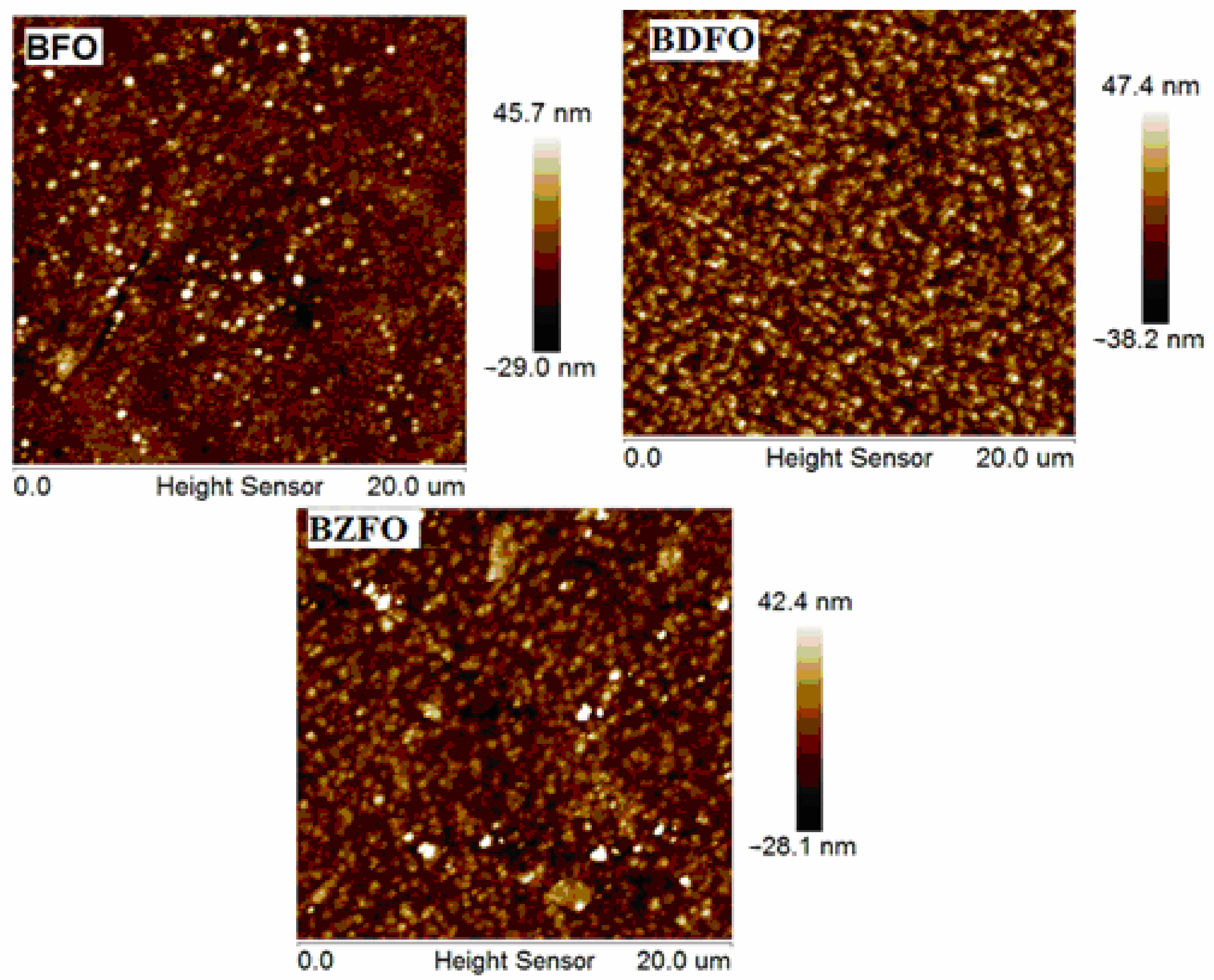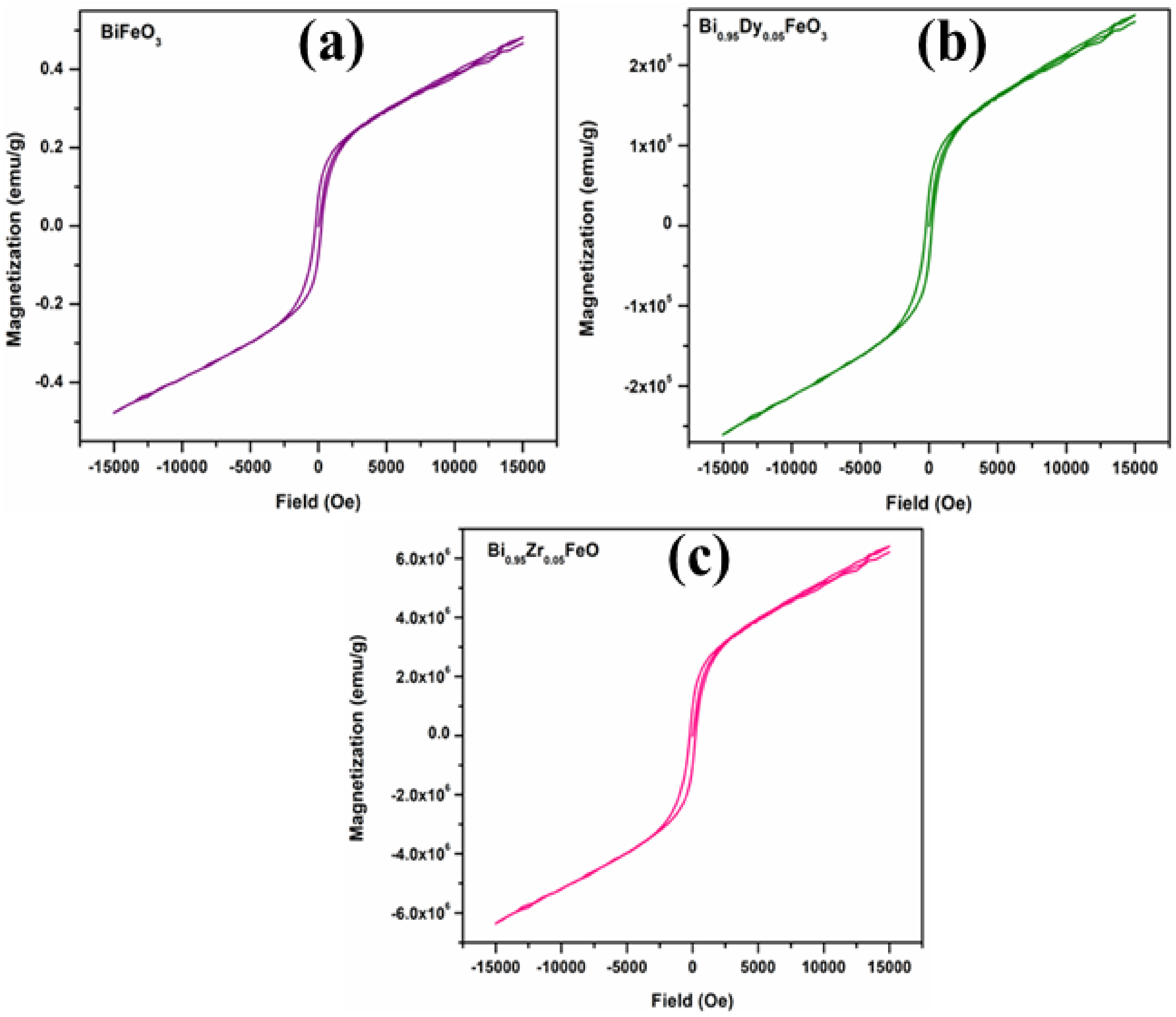Tunable Optical and Multiferroic Properties of Zirconium and Dysprosium Substituted Bismuth Ferrite Thin Films
Abstract
1. Introduction
2. Experimental Methods
2.1. Preparation of Precursor Solution
2.2. Device Fabrication
3. Results and Discussion
3.1. Structural Analysis
3.2. Optical Study
3.3. Surface Morphology and Domain Structure Analysis
3.4. Ferromagnetic Analysis
3.5. Ferroelectric Analysis
4. Conclusions
Author Contributions
Funding
Institutional Review Board Statement
Informed Consent Statement
Data Availability Statement
Conflicts of Interest
References
- Chen, X.-Y.; Su, K.-R.; Ling, S.-W.; Li, C.-S.; Lai, G.-X.; Luo, G.-P.; Xu, X.-F.; Ji, H.; Tang, J.-J. Theoretical study on the multiferroic materials In2FeX (X = V, Cr, Mn, Co, and Ni)O6 for high photovoltaics and photocatalysis performance. Results Phys. 2022, 35, 105368. [Google Scholar] [CrossRef]
- Liu, F.; Huang, S.; Yang, F. Direct fabrication of single phase multiferroic BiFe0.95Co0.05O3 films on polyimide substrates for flexible memory. Thin Solid Film. 2022, in press. [Google Scholar] [CrossRef]
- Wei, M.; Hao, J.; Liu, M.; Yang, L.; Xie, Y.; Wang, X.; Li, Z.; Su, Y.; Hu, Z.; Liu, J.-M. High-performance self-driven photodetectors based on self-polarized Bi0.9Eu0.1FeO3/Nb-doped SrTiO3 p-n heterojunctions. J. Alloy. Compd. 2022, 915, 16544451. [Google Scholar] [CrossRef]
- Hsu, Y.-H.; Chen, P.-Y.; Tub, C.-S.; Chen, C.-S.; Anthoniappen, J. Polarization-enhanced photovoltaic response and mechanisms in Ni-doped (Bi0.93Gd0.07)FeO3 ceramics for self-powered photodetector. J. Eur. Ceram. Soc. 2021, 41, 1934–1944. [Google Scholar] [CrossRef]
- Pinto, V.M.; Arya, M.; Niharika; Nilakanthan, V.; Kumara, K.; Shetty, T.C.S. Multiferroic bismuth ferrite nanomagnets as potential candidates for spintronics at room temperature. Mater. Today Proc. 2021, 55, 42–45. [Google Scholar] [CrossRef]
- Priya, A.S.; Banu, I.B.S.; Chavali, M. Influence of (La, Cu) doping on the room temperature multiferoic properties of BiFeO3 ceramics. Arab. J. Sci. Eng. 2015, 40, 2079–2084. [Google Scholar] [CrossRef]
- Song, J.F.; Zhuang, S.H.; Martin, M.; Ortiz-Flores, L.A.; Paudel, B.; Yarotski, D.; Hu, J.M.; Chen, A.P.; Huey, B.D. Interfacial-Strain-Controlled Ferroelectricity in Self-Assembled BiFeO3 Nanostructures. Adv. Funct. Mater. 2021, 31, 2102311. [Google Scholar] [CrossRef]
- Zhang, C.C.; Dai, J.Q.; Liang, X.L. Enhanced ferroelectric properties of (Zn, Ti) equivalent co-doped BiFeO3 films prepared via the sol-gel method. Ceram. Int. 2021, 47, 16776. [Google Scholar] [CrossRef]
- Priya, A.S.; Geetha, D. Studies on the multiferroic properties and impedance analysis of (La, Cu) BiFeO3 prepared by sol-gel method. Ferroelectrics 2021, 573, 103–115. [Google Scholar] [CrossRef]
- Mumtaz, F.; Nasir, S.; Jaffari, G.H.; Shah, S.I. Chemical pressure exerted by rare earth substitution in BiFeO3: Effect on crystal symmetry, band structure and magnetism. J. Alloy. Compd. 2021, 876, 160178. [Google Scholar] [CrossRef]
- Ahn, Y.; Son, J.Y. Ferromagnetic properties of conducting filament nanodots formed on epitaxial BiFeO3 thin film. J. Mater. Res. Technol. 2022, 18, 2232–2239. [Google Scholar] [CrossRef]
- Zhang, Y.; Sun, H.J.; Yang, C.Q.; Su, H.T.; Liu, X.F. Modulating Photovoltaic Conversion Efficiency of BiFeO3-Based Ferroelectric Films by the Introduction of Electron Transport Layers. ACS Appl. Energy Mater. 2019, 2, 5540. [Google Scholar] [CrossRef]
- Li, K.; Zhang, W.; Guo, K.; Cui, R.; Deng, C.; Wang, X. Modulating light absorption and multiferroic properties of BiFeO3-based ferroelectric films by the introduction of ZnO laye. Mater. Res. Exp. 2022, 9, 036402. [Google Scholar] [CrossRef]
- Zhu, H.; Yang, Y.; Ren, W.; Niu, M.; Hu, W.; Ma, H.; Ouyang, J. Rhombohedral BiFeO3 thick films integrated on Si with a giant electric polarization and prominent piezoelectricity. Acta Mater. 2020, 200, 305–314. [Google Scholar] [CrossRef]
- Akhtar, M.N.; Yousaf, M.; Baqir, M.; Batoo, K.M.; Khan, M.A. Pr–Co co-doped BFO multiferroics nanomaterials for absorber applications. Ceram. Int. 2020, 47, 2144–2154. [Google Scholar] [CrossRef]
- Mohanty, B.; Bhattacharjee, S.; Nayak, N.; Parida, R.; Parida, B. Dielectric, magnetic and optical study of La- doped BFO-BST ceramic for multifunctional applications. Mater. Sci. Semicond. Process. 2021, 128, 105720. [Google Scholar] [CrossRef]
- Das, T.; Mojumder, S.; Chakraborty, S.; Saha, D.; Pal, M. Beneficial effect of Sn doping on bismuth ferrite nanoparticle-based sensor for enhanced and highly selective detection of trace formaldehyde. Appl. Surf. Sci. 2022, 602, 154340. [Google Scholar] [CrossRef]
- Shinjo, Y.; Mori, M.; Fujihara, S.; Hagiwara, M. Ti doping and low-temperature sintering of BiFeO3 nanoparticles synthesized by the solvothermal method. Ceram. Int. 2022, in press. [Google Scholar] [CrossRef]
- Kumar, K.S.; Sudharani, A.; Ramanadha, M.; Ramu, S.; Murali, G.; Vijayalakshmi, R. Enhanced magnetization and dielectric properties of Ca doped BiFeO3: Er nanoparticles by sol–gel technique. Mater. Sci. Eng. B 2021, 270, 115235. [Google Scholar] [CrossRef]
- Sreekanth, K.; Dhanalakshmi, B.; Madhavaprasad, D. Enhanced dielectric and magnetic properties of Cr/Co and Mn co-doped single phase multiferroic bismuth ferrite nanoparticles. J. Indian Chem. Soc. 2022, 99, 100649. [Google Scholar] [CrossRef]
- Aissa, M.; Zannen, M.; Alzahrani, H.A.H.; Belhadi, J.; Hadouch, Y.; Mezzane, D.; el Marssi, M.; Majdoub, M.; Lahmar, A. Multifunctionality of rare earth doped 0.925Na0.5Bi0.5TiO3-0.075K0.5Na0.5NbO3 ferroelectric ceramics. J. Alloy. Compd. 2022, 921, 166188. [Google Scholar] [CrossRef]
- Apostolov, A.T.; Apostolova, I.N.; Wesselinowa, J.M. Magnetic field effect on the dielectric properties of rare earth doped multiferroic BiFeO3. J. Magn. Magn. Mater. 2020, 513, 167101. [Google Scholar] [CrossRef]
- Nair, S.G.; Satapathy, J.; Kumar, N. Effect of holmium (Ho) partial substitution in structure and ferroelectric properties of bismuth ferrites (BFO). J. Alloy. Compd. 2021, 895, 162599. [Google Scholar] [CrossRef]
- Kossar, S.; Amiruddin, R.; Rasool, A.; Kumar, M.C.S.; Katragadda, N.; Mandal, P.; Ahmed, N. Study on ferroelectric polarization induced resistive switching characteristics of neodymium doped bismuth ferrite thin films for random access memory applications. Current. Appl. Phys. 2022, 39, 221–229. [Google Scholar] [CrossRef]
- Kathirvel, A.; Krishna, K.I.; Ganga, R.; Maheswari, A.U.; Sivakumar, M. Enhanced magnetic, dielectric and photoconductive properties of Zr doped BiFeO3 nanostructures. Phys. E Low-Dimens. Syst. Nanostructures 2022, 142, 115306. [Google Scholar] [CrossRef]
- Liu, J.P.; Lv, Z.L.; Hou, Y.X.; Zhang, L.P.; Cao, J.P.; Wang, H.W.; Zhao, W.B.; Zhang, C.; Bai, Y.; Meng, K.K.; et al. Substatial reduction of Leakage currents in La/Er/Zn/Ti multielement doped BiFeO3 multiferroic thin films. Ceram. Intern. 2022, 448, 17328–27334. [Google Scholar] [CrossRef]
- Sahni, M.; Kumar, S.; Chauhan, S.; Singh, M.; Pandit, S.; Sati, P.C.; Kumar, M.; Kumar, A.; Kumar, N. Structural, optical and photocatalytic properties of Ni doped BiFeO3 nanoparticles. Mater. Today Proc. 2022, 49, 3015–3021. [Google Scholar] [CrossRef]
- Priya, A.S.; Geetha, D.; Ţălu, S. Advanced micromorphology study of the Mn-doped bismuth ferrite thin films. Mater. Lett. 2020, 281, 128615. [Google Scholar] [CrossRef]
- Ţălu, Ş.; Priya, A.S.; Geetha, D. Topographic characterization of (Zr, Mn) co-doped Bismuth ferrite thin film surfaces. Microsc. Res. Techn. 2021, 84, 2494–2500. [Google Scholar] [CrossRef]
- Ţălu, Ş. Micro and Nanoscale Characterization of Three Dimensional Surfaces. Basics and Applications; Napoca Star Publishing house: Cluj-Napoca, Romania, 2015; ISBN 978-606-690-349-3. [Google Scholar]
- Cullity, B.D. Elements of X-ray Diffraction, 2nd ed.; Addison-Wesley Publishing Company Inc.: Menlo Park, CA, USA, 1978. [Google Scholar]
- Song, T.K.; Lee, M.H.; Lee, S.C.; Sung, Y.S.; Kim, M.-H.; Kim, W.-J.; Do, D.; Kim, S.S.; Cho, J.H.; Choi, B.C.; et al. Improvement of the Ferroelectric and the Leakage Current Properties with Mn Doping in BiFeO3 Thin Films. J. Korean Phys. Soc. 2010, 57, 1901–1904. [Google Scholar] [CrossRef]
- Priya, A.S.; Geetha, D.; Henry, J. Effect of Cu and Sm doping on the ferroelectric character of bismuth ferrite thin films. Phosphorus Sulfur Silicon Relat. Elements 2021, 197, 158–163. [Google Scholar] [CrossRef]
- Yang, S.; Zhang, F.; Xie, X.; Sun, H.; Zhang, L.; Fan, S. Enhanced leakage and ferroelectric properties of Zn-doped BiFeO3 thin films grown by sol-gel method. J. Alloy. Compd. 2018, 734, 243–249. [Google Scholar] [CrossRef]
- Dutta, D.P.; Jayakumar, O.D.; Tyagi, A.K.; Girija, K.G.; Pillai, C.G.S.; Sharma, G. Effect of doping on the morphology and multiferroic properties of BiFeO3 Nanorods. Nanoscale 2010, 2, 1149–1154. [Google Scholar] [CrossRef] [PubMed]
- Rodríguez, A.C.; Rodríguez, E.R.; Celis, D.C.; Duran, N.V.; da Cruz, A.S.E.; Londoño, O.M.; Béron, F.; Knobel, M.; Reiber, A.; Muraca, D.; et al. Resolving magnetic contributions in BiFeO3 nanoparticles using First order reversal curves. J. Magn. Magn. Mater. 2022, 556, 169409. [Google Scholar] [CrossRef]
- Zhang, Y.; Wang, Y.; Qi, J.; Tian, Y.; Sun, M.; Zhang, J.; Hu, T.; Wei, M.; Liu, Y.; Yang, J. Enhanced Magnetic Properties of BiFeO3 Thin Films by Doping: Analysis of Structure and Morphology. Nanomaterials 2018, 8, 711. [Google Scholar] [CrossRef]
- Ahmmad, B.; Islam, M.Z.; Billah, A.; A Basith, M. Anomalous coercivity enhancement with temperature and tunable exchange bias in Gd and Ti co-doped BiFeO3 multiferroics. J. Phys. D Appl. Phys. 2016, 49, 095001. [Google Scholar] [CrossRef]
- Chen, J.Y.; Yao, W.; Yuan, D. Combined effects of Bi deficiency and Mn substitution on the structural transformation and functionality of BiFeO3 films. J. Appl. Phys. 2014, 116, 174102. [Google Scholar] [CrossRef]
- Sati, P.C.; Arora, M.; Chauhan, S.; Kumar, M.; Chhoker, S. Effect of Dy substitution on structural, magnetic and optical properties of BiFeO3 ceramics. J. Phys. Chem. Solid. 2014, 75, 105–108. [Google Scholar] [CrossRef]
- Arora, M.; Chauhan, S.; Sati, P.C.; Kumar, M. Effect of Non-magnetic ions substitution on structural, magnetic and optical properties of BiFeO3 nanoparticles. J. Supercond. Nov. Magn. 2014, 27, 1867–1871. [Google Scholar] [CrossRef]
- Lan, C.; Jiang, Y.; Yang, S. Magnetic properties of La and (La, Zr) doped BiFeO3 ceramics. J. Mater. Sci. 2011, 46, 734–738. [Google Scholar] [CrossRef]
- Wei, J.; Xue, D. Effect of non-magnetic doping on leakage and magnetic properties of BiFeO3 thin films. Appl. Surf. Sci. 2011, 258, 1373–1376. [Google Scholar] [CrossRef]
- Ma, Z.; Liu, H.; Wang, L.; Zhang, F.; Zhu, L.; Fan, S. Phase transition and multiferroic properties of Zr-doped BiFeO3 thin films. J. Mater. Chem. C 2020, 8, 17307–17317. [Google Scholar] [CrossRef]
- Yan, X.; Tan, G.; Liu, W.; Ren, H.; Xia, A. Structural, electric and magnetic properties of Dy and Mn co-doped BiFeO3 thin films. Ceram. Int. 2015, 41, 3202–3207. [Google Scholar] [CrossRef]
- Sharif, M.K.; Khan, M.A.; Hussaina, A.; Iqbala, F.; Shakirb, I.; Murtazac, G.; Akhtard, M.N.; Ahmadd, M.; Warsi, M.F. Synthesis and characterization of Zr and Mg doped BiFeO3 nanocrystalline multiferroics via micro emulsion route. J. Alloy Compd. 2016, 667, 329–340. [Google Scholar] [CrossRef]
- Dupuy, A.D.; Kodera, Y.; Carman, G.P.; Garay, J.E. Effect of phase homogeneity and grain size on ferroelectric properties of 0.5Ba(Zr0.2Ti0.8)O3-0.5(Ba0.7Ca0.3)TiO3 (BXT) lead-free ceramics. Scr. Mater. 2019, 159, 13–17. [Google Scholar] [CrossRef]








| Thin Films | Lattice Constant (Å) | Bi-O (Ả) | Fe-O (Å) | Dislocation Density ×10−4 | Tolerance Factor | |
|---|---|---|---|---|---|---|
| a | c | |||||
| BFO | 5.7038 | 13.565 | 2.5475 | 1.7868 | 7.71 | 0.7640 |
| BDFO | 5.756 | 13.794 | 2.5271 | 1.821 | 5.38 | 0.7632 |
| BZFO | 5.596 | 13.755 | 2.4877 | 1.8642 | 4.52 | 0.7624 |
| Thin Films | Saturation Magnetization (emu/g) | Coercive Field (Oe) | Remnant Magnetization (emu/g) |
|---|---|---|---|
| BFO | 15,053.54 | 224.705 | 0.07048 |
| BDFO | 14,806.425 | 233.53 | 39,163.6346 |
| BZFO | 641,777.53 | 221.442 | 1,014,534.83 |
| Samples | Saturation Magnetization (emu/g) | Coercive Field (Oe) | Remnant Magnetization (emu/g) | Remnant Polarization (C/cm2) | Reference |
|---|---|---|---|---|---|
| Bi0.95Dy0.05FeO3 | 0.0314 | [40] | |||
| BiFe0.97Zr0.03O3 | 9.33 | 28.577 | 0.229 | [41] | |
| BiFe0.90Zr0.10O3 | 8.14 | 17.192 | 0.143 | [41] | |
| Bi0.9La0.1Fe0.98Zr0.02O3 | 0.013 | [42] | |||
| BiFe0.90Zr0.05O3 | 48 | [43] | |||
| BiFe0.90Zr0.10O3 | 52.1 | [44] | |||
| BiFeO3 | 113 | 0.12 | [45] | ||
| Bi0.90Dy0.10FeO3 | 0.32 | [46] | |||
| BiFe1−2xZrxMgxO3 (x = 0.05) | 0.649 | 152.5 | 0.108 | [47] |
| Thin Films | Coercive Field (kV/cm) | Remnant Polarization (μC/cm2) |
|---|---|---|
| BZFO | 2.958 | 0.15589 |
| BDFO | 5.7966 | 0.25617 |
| BFO | 1.47564 | 0.20475 |
Publisher’s Note: MDPI stays neutral with regard to jurisdictional claims in published maps and institutional affiliations. |
© 2022 by the authors. Licensee MDPI, Basel, Switzerland. This article is an open access article distributed under the terms and conditions of the Creative Commons Attribution (CC BY) license (https://creativecommons.org/licenses/by/4.0/).
Share and Cite
Priya, A.S.; Geetha, D.; Siqueiros, J.M.; Ţălu, Ș. Tunable Optical and Multiferroic Properties of Zirconium and Dysprosium Substituted Bismuth Ferrite Thin Films. Molecules 2022, 27, 7565. https://doi.org/10.3390/molecules27217565
Priya AS, Geetha D, Siqueiros JM, Ţălu Ș. Tunable Optical and Multiferroic Properties of Zirconium and Dysprosium Substituted Bismuth Ferrite Thin Films. Molecules. 2022; 27(21):7565. https://doi.org/10.3390/molecules27217565
Chicago/Turabian StylePriya, A. Sathiya, D. Geetha, J. M. Siqueiros, and Ștefan Ţălu. 2022. "Tunable Optical and Multiferroic Properties of Zirconium and Dysprosium Substituted Bismuth Ferrite Thin Films" Molecules 27, no. 21: 7565. https://doi.org/10.3390/molecules27217565
APA StylePriya, A. S., Geetha, D., Siqueiros, J. M., & Ţălu, Ș. (2022). Tunable Optical and Multiferroic Properties of Zirconium and Dysprosium Substituted Bismuth Ferrite Thin Films. Molecules, 27(21), 7565. https://doi.org/10.3390/molecules27217565







